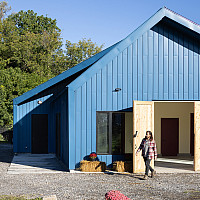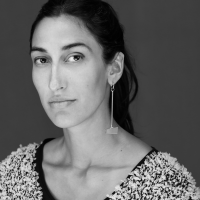COVER LETTER BASICS
How do I write a cover letter?
A cover letter “covers” your resume whenever you are sending it by mail or e-mail. The 3 paragraphs should be well organized and brief. Your goal is to provide information not already on your resume, highlight details of your resume, and add a more “human” story to accompany the resume.
Use business letter format (see example): text justified left margin.
The best cover letters are the ones that give evidence of the research you have done. Research helps you find a firm that is a good “fit” for you, and makes it possible to write a personal cover letter tailored to the work and needs of the firm.
- First Paragraph: Show Your Research - Write about THEM.
Your signature will let the reader know who you are; avoid sentences such as, “I am a third-year Architecture student at Syracuse University”, or “My name is Jane Doe“. Aim instead for a more direct opening tailored to the work of that specific firm. This approach gives the recruiter the impression that your cover letter is both focused and personal. It is important that your letter appear to be personally tailored to this specific firm. The first paragraph should also name the position in which you are interested.
Two effective techniques for accomplishing this task are:
“During a recent phone call with Pat Buckley, a Syracuse University alum working in your firm, I learned that your firm is now working on the XYZ Hotel project in Hong Kong. Since the focus of my thesis was a hotel on a Hong Kong site, I am naturally very interested in your new project.”
“In a recent Architecture class, we discussed the various revival modes, which contributed to the development of new commercial and residential forms prior to World War II. I know that ABC Architects is well-respected in this field, and I am interested in a full-time job with your firm.”
- Second Paragraph: More about YOU
Tell the reader how your skills, abilities, and attributes relate to the firm’s requirements. Firms are less interested in hearing that you are willing to learn from them; they want to pay you for the skills that you will contribute. Do not rehash everything on your resume, but instead refer in detail to one or two items that directly relate to the position you are seeking. If you have been networking with alumni/ae or others, use information gleaned from that conversation to create this paragraph. For instance, if the alum told you that the firm needs someone with knowledge of New York State Building Codes, be sure to discuss that. This paragraph should be 3 – 4 sentences, as follows:
“During my internship with SBJ in Manhattan, I was involved in the historical preservation of a first class hotel, which allowed me to strengthen my knowledge of NY state building codes as well as to utilize my CAD skills. I believe that my experience with SBJ would be of benefit to your firm.”
- Third Paragraph: Close with your contact info
Tell the reader that you will call next week to confirm receipt of the resume and that your portfolio and references are available. Repeat your phone number and e-mail address because letters often are separated from resumes. Finally, thank the reader for his/her time.
Caution:
Recruiters will often throw away any resume/cover letter package that has a spelling error or typo. Have a friend, career advisor and/or faculty member proofread your written materials … and use built-in software spelling/grammar tools wisely.
If you have a graphic design on your resume, you can consider using that on your cover letter, too. Be mindful, however, that most architects prefer resumes and cover letters that are “elegant”. When developing graphics, it is important to know your audience.
Attaching Cover Pages and Email Body Text
If you are emailing your resume, should the cover letter be the text in the email or the first page of a three page (cover letter, resume, sample page) pdf? Last year I (perhaps incorrectly) assumed it should be the text in the email. Then when talking to the firm on the phone, they asked if I had included a cover letter.
Following that, if the cover letter is part of the pdf, what should the email say?
If you do not have any personal contacts at the firm, it is best to make the cover letter page one of a three-page PDF. The body of the e-mail would say:
“Dear Mr. Smith,
Please see attached PDF (3 pages) for a copy of my cover letter, resume, and sample page. I am interested in an architect intern position.
Sincerely,
Jane Doe”
If you are already “chummy” with your contact, you can write a more casual letter in the body of the e-mail, and then mention the attachments as above.
How can I maximize the chances someone will call back if I leave a voicemail?
Have you ever rec’d a voice mail that is well-detailed but then you can’t hear the person’s name and you only get about 8 digits for the return phone number?
A seasoned professional will announce his/her name at the beginning of a voice mail and then repeat it at the end —- pronounced slowly and audibly.
Also, the person will always offer a return phone # (even if the person “knows” that I have it … why make me look it up?) and then repeat the phone # a second time slowly and audibly.
How do I contact a firm when I don’t know anyone there?
I am interested in a firm where there are no alums. It appears to be a small firm, and they do not have an email address listed on their website. Instead, they have a screen to enter your name, e-mail address and leave a brief message. They also list their physical address. I am very interested in contacting the firm and exploring the potential of employment with them.
How should I go about this?
Should I write them a message on their website asking if I can send my resume and sample page?
Or should I send a cover letter, resume, and sample page by mail to the physical address?
Send a Resume, Cover Letter, and two to three sample pages.
Make sure one of the sample pages has images from your thesis or current design project process, schematic, study models trace it is all good, so choose 3 to 5 good images and scan them well.
The top of the extra sample page(s) will have your name/address heading as you have on your resume, but you might only have one image on a page if it’s a good one. The best image you have should be included in what you send.
Cover letter on good paper (no watermark) and print all image pages on gorgeous 60# minimum paper, not stapled or bound, and use a white 8 x11 envelope.
In your cover letter, begin by talking about the project(s) that intrigues you the most. In the 2nd paragraph, briefly describe your skills and work ethic.
The cover letter and mailing envelope should be addressed to one of the principals. Usually I look on the site for the bio of the principal(s) and hope the bio says something about who is the “business” partner, who is marketing, who is design. If you can’t tell, just pick one! If you can’t get any name at all, use “Dear Hiring Manager:”.
You can also Google the principals to learn more. And check for them on http://www.linkedin.com. Even Facebook?
Should I send both a digital and a hard copy of my docs?
Always attach your resume and sample page in any e-mail you send to employers right from the first email so that they have a “picture” of who you are. Email can be so impersonal compared to a phone call. At least in a phone call, you are connecting by voice.
You do not need to send hard copies of your docs unless requested… or unless you want to give yourself the extra advantage of getting your docs in front of them twice and allowing them to see your docs printed as you intended and on gorgeous paper.
As a favor, a friend is sending my resume to a few firms in NYC, but I need to include a cover letter.
Do I address the letter “To Whom it May Concern” or “Dear Sir or Madam”?
Basically, if a cover letter is not addressed to a specific person, the letter is not very valuable.
1. If your friend is giving the resumes to personal contacts, she must know their names. So she would give you the names, and you would use a specific name for each letter.
2. If your friend is passing your resumes to people she does not know, but she does know the name of the firm, look the firm up on the internet and find the name of a principal or human resources professional for the letter.
3. If you absolutely have no way to get a name, address the letter:
“Dear Hiring Manager:”
Bottom line? Get a name! When you know the name of a firm, use the firm’s website to learn the name of a principal or hiring manager.
The Proper Greeting
When writing a cover letter, whether on paper or e-mail you need to use the proper greeting.
Note the Mr. and Ms. titles and the punctuation.
Do not use “Mrs.” at all in a business letter.
No matter which greeting you use, you will only use one name for the person.
To someone you know well:
Dear Jane,
Dear Tom,
To someone you have never met:
Dear Ms. Smith:
Dear Mr. Smith:
To someone you have met and is also 10 years older than you are or is a Senior Associate or Principal: Dear Mr. Smith, Dear Ms. Smith,
The only time you use both names is in the address at the top of the letter.
However, in the address, you do not use Mr. or Ms. Titles. So the top margin of the letter begins with your address and follows as seen below:
Your Address Only (do not put your name at the top)
Skip Line Space:
Date:
Skip Line Space:
Thomas Smith, Principal
123 Dim Street
Dimsville, NY
Dear Mr. Smith:
A job posting requests that I send a cover letter, resume, and portfolio via e-mail only (i.e., 5 mb max). Does it mean an actual full portfolio? And if they say they want a cover letter, resume, and work samples, what does “work samples” entail?
The typical e-mail for either one of these requests would be a resume, cover letter and 3 sample pages with about 10 - 15 images total.











